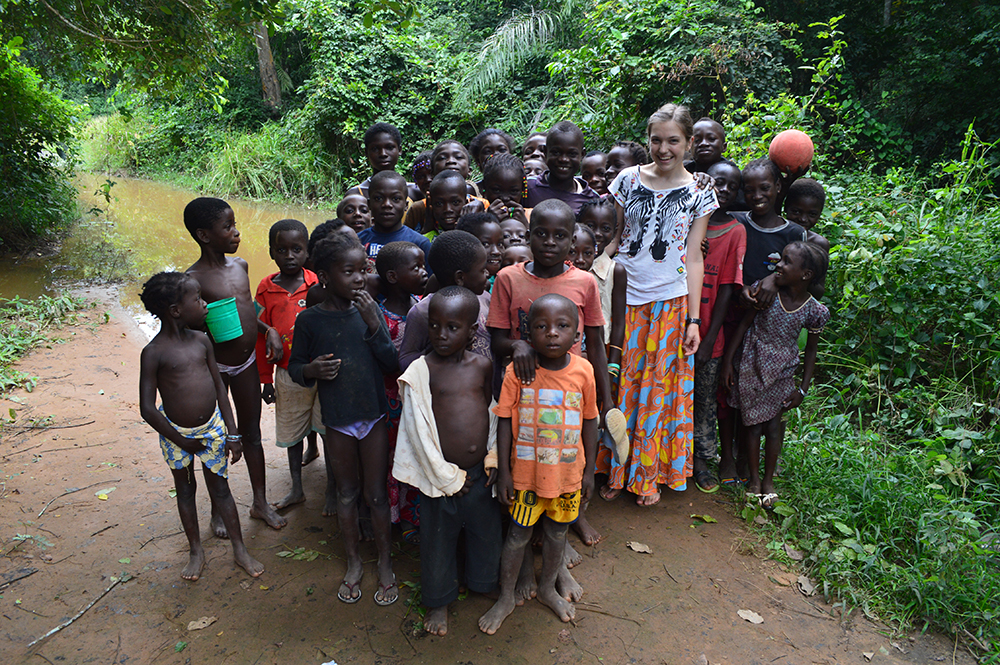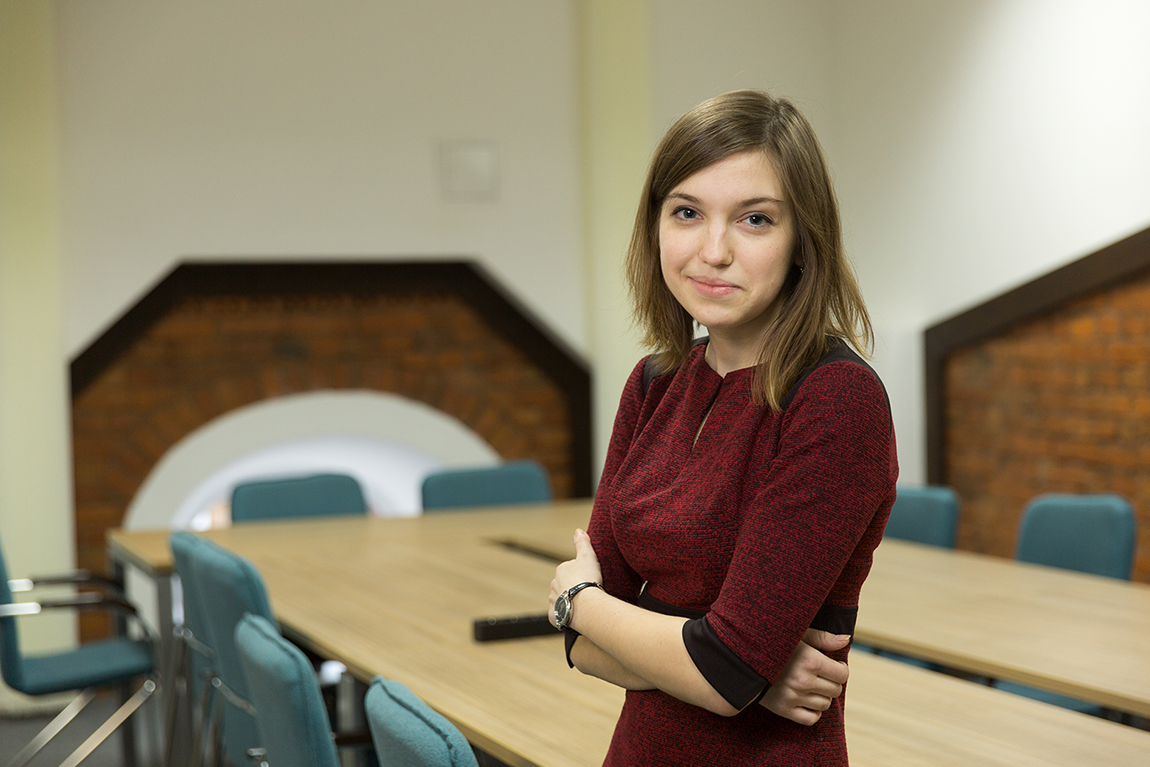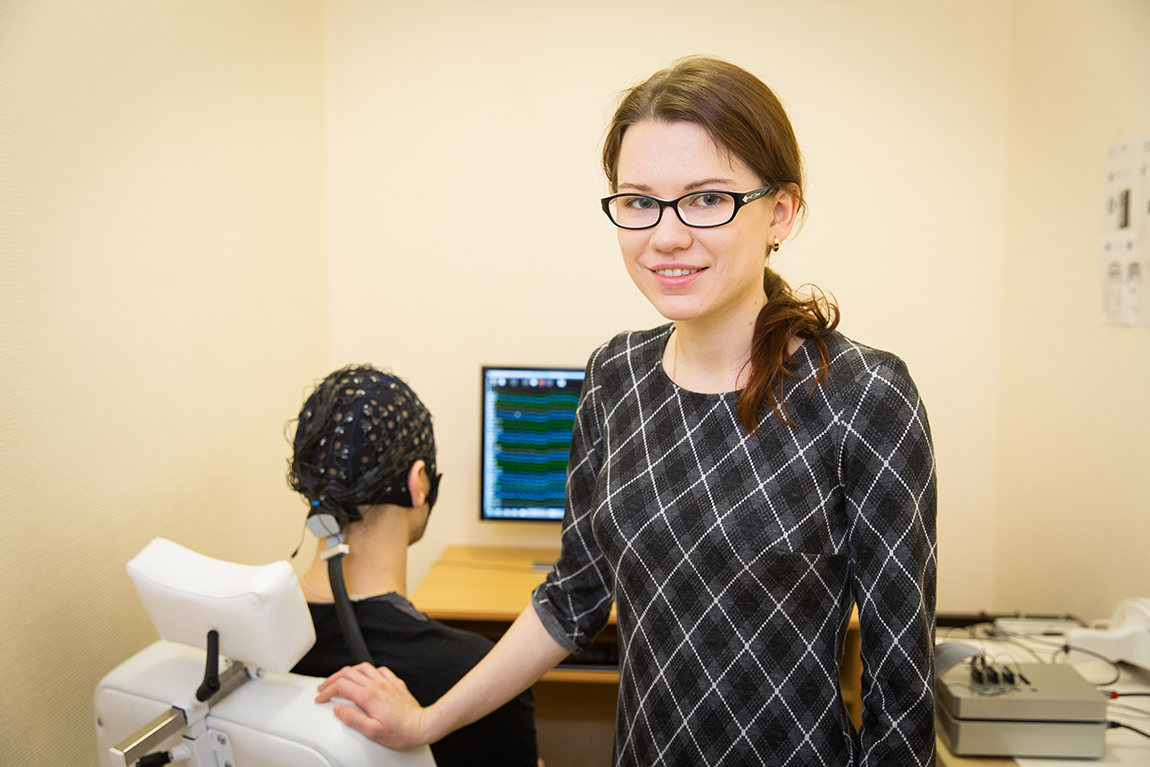Everyone Wants to Be a Pioneer: HSE Students Study African Languages, the Mind, and Military Dictatorships
The Higher School of Economics is very serious about students getting involved in undergraduate research. For Russian Science Day, celebrated on February 8, the HSE News Service spoke with three young HSE researchers about their work and learned how the students set goals for themselves, achieve results, and move forward with what some might deem frighteningly ambitious research ideas.
Anna Maloletnyaya, first-year student in the Theoretical and Computational Linguistics Master's Programme
A Story on African Languages and How to Set the Right Goals
In the summer of 2014, during a French expedition to Africa’s Ivory Coast, Anna Maloletnyaya discovered the Ngen language. Strictly speaking, researchers had already been aware of Ngen, but the language’s status was not yet clear. According to one theory, Ngen was a dialect of the Beng, which is spoken in the central western part of the Ivory Coast. Another theory posits that Beng and Ngen are completely different languages. Anna found that Ngen can in fact be considered an independent language. She was just 20 years old at the time and had just finished her third year in the Fundamental and Applied Linguistics programme.
The expedition to the Ivory Coast was organized by Valentin Vydrin (St Petersburg State University, Russia and Llacan, France), one of the most prominent Russian scholars in the sphere of African studies. He invited Anna and Maria Sapozhnikova, also from HSE, to take part in the expedition. They were selected for their background in fundamental linguistics and knowledge of French, which is the second official language of the Ivory Coast.
It is believed that a 10%-12% congruency rate is enough to declare that two comparable idioms are of different languages, not dialects. Anna discovered that 36% of the words were different
Anna noted that her dreams of going to Africa also motivated her to improve her French. ‘Who on earth wouldn’t want to be a pioneer?’ Anna comments. ‘I understood that I couldn’t just get on a boat and discover a new island or discover a new particle, star or planet; but I knew I could find something new in human language, especially in Africa where there is so much that has not been studied yet!’
Field work of a linguist is not an easy task, especially in Africa. Anna and Maria had to learn a lot. Prof Vydrin supported them in their work and mapped out interesting areas of research. Each participant of the expedition had a specific task assigned by Prof Vydrin. ‘The Beng language has four dialects, including a dialect of the village Djonkro. It is most different from all the others. My task was to check whether it was a just a dialect or if it was in fact a separate language,’ Anna recalls.
By the time she headed to Djonkro, Anna already knew that the locals considered Beng and Ngen to be separate languages. This self-identification is the first sign that we are talking about a language and not a dialect. But to determine this once and for all, an informant was needed – a native speaker of the language who came from the region. The informant had to know both the language being studied, as well as French. In addition, he or she had to be relatively young, as older people pronounce certain sounds differently. Also, the informant had to have their front teeth, an important aspect of pronunciation. Lastly, the person needed to be able to read. Anna’s informant was named Sialo, and he was able to read but did not have his front teeth. This did not end up affecting Anna’s work.

Initially, Anna used the Swadesh list – a list of 100 ‘basic’ words that exist in almost every language – to begin determining the lexical differences between Beng and Ngen. An example would be whether or not the words for ‘night’ and ‘woman’ sound the same in both languages. It is believed that a 10%-12% congruency rate is enough to declare that two comparable idioms are of different languages, not dialects. Anna discovered that 36% of the words were different. Anna also used the informant to study the grammar of the language.
But vocabulary, grammar, and even phonetics are not enough. It’s also necessary to collect texts in the language being studied. This allows researchers to work without an informant.
At first, it was difficult for Anna to work with the texts. ‘My informant didn’t open up right away,’ she remembers. ‘Because of my inexperience, I tried to get information from him right off the bat – “tell me a story, tell me a fairy tale.” But he said he didn’t know any. I was upset with him and him with me.’ But then the researcher and the native speaker got used to one another, and the informant also became interested in what they were doing, which made things move much faster. The local got into it and even tried to go above and beyond what was being asked. As one example, Anna asked him to provide literal translations of recipes for local dishes into French. She got these recipes from one of the villagers, but Sialo said that the recipes weren’t correct and offered his own.
With just two weeks of work underway, Anna was certain that people of Djonkor did indeed speak a separate language – Ngen. The new language was already endangered, however; at the time, there were only 765 native speakers, and most of them were middle-aged.
Immediately after the expedition, Anna took part in the language colloquium in Burkina Faso - 4e Colloque Langues et Linguistique Mandée. Anna also wrote her thesis on Ngen, and she has presented her findings at several conferences in Russia, including the XI Conference on Typology and Grammar for Young Researchers in St. Petersburg, and the IV Conference on Language Problems from Young Researchers’ Viewpoint in Moscow. She is also going to the Niger-Congo language conference in Paris this year. Anna notes that in 2016, a new volume of the international ethnologue Languages of the World will be published dedicated to Mande languages. Ngen will be mentioned in this volume as a separate language now. It will also include an article about Beng that Anna co-authored with the linguist Denis Paperno.
In the summer of last year, Anna began her master’s degree, which is why she has not been able to go on another expedition. She hopes that Professor Vydrin will invite her to be part of his research group again and that she’ll have the opportunity to continue working in Africa. ‘There are still uncharted waters there for researchers,’ she says.
Other stories:
Elizaveta Okorokova, second-year student in the ‘Cognitive Sciences and Technologies: From Neuron to Cognition’ master’s programme
A Story on How an Economist Is Helping Create ‘Smart’ Artificial Limbs
The School of Psychology is home to the Centre for Cognition & Decision Making, which conducts research at the forefront of neuroscience with the help of modern technologies such as transcranial magnetic stimulators, myograms, and multi-channel EEG. Taking part is this groundbreaking research are psychologists, neuroscientists, economics, linguistics, physicists, and engineers from countries such as Russia, Italy, Turkey, England, the U.S., and Spain. One such research group includes Elizaveta Okorokova, whose work might lead to the creation of smart prosthetic limbs.
Elizaveta’s story is a shining example of how open and interdisciplinary contemporary science truly is. Though she is currently a second-year student in the Cognitive Sciences and Technologies: From Neuron to Cognition’ master’s programme, Elizaveta actually completed her bachelor’s in economics from the HSE International College of Economics and Finance (ICEF).
‘As a student in ICEF, I worked with Alexei Belyanin in the Laboratory for Experimental and Behavioural Economics, where we studied people’s behaviour in economic situations,’ Elizaveta says. ‘There came a point when I realised that you could look at this problem from a different light and from a biological point of view. What processes occur in a person’s head when making a decision? I became fascinated by this question, and Alexei recommended that I read about neuroscience. He introduced me to Vasily Klyucharev and Anna Shestakova, who work in the field in the School of Psychology. They told me that the programme was accepting new students, which really interested me, so I decided to delve further into the subject,’ Elizaveta comments.
And that is exactly what she did – after just a year, Elizaveta’s researched was published in the international journal Frontiers in Neuroscience.
The idea for the study partially came from HSE Professor Alexey Ossadtchi and Mikhail Lebedev from Duke University, who are both Elizaveta’s academic supervisors. The original idea concerned handwriting recognition based on a myogram, i.e., signals that are non-invasively read from the surface of human muscles, in this case wrists.
But how can an economist understand these signals? This is possible because the same data analysis methods used in the field of economics and finance are somewhat similar to those used in neuroscience. ‘Since I had prior experience in finance and exchange processing signals, I was able to quickly switch over to processing temporary series of a neurophysiological nature,’ Elizaveta explains.
Data analysis methods used in the field of economics and finance are somewhat similar to those used in neuroscience
It is worth noting that very few researchers previously studied this area; aside from Duke University specialists, almost nobody had focused on handwriting recognition. Mikhail Lebedev was able to build a linear model that recognised the coordinates of a pen using a myogram. This model was improved upon at HSE, with dynamic properties being added to the system, allowing for the volume of necessary data to be decreased while the ergonomics of restored trajectories was increased.
What was done exactly? A myogram has signals that can be read from a person’s hand muscles, and there are also coordinates that reflect changes in where a person is holding the pen on the paper while writing. The objective was to think of a model that would best link the myogram’s signals to these coordinates.
Many tech companies are busy developing gadgets that use similar principles, but this mostly concerns intermittent recognition, whereby only separate movements can be modelled. ‘What we’ve done recognises not individual changes, but continuous alterations in coordinates on a piece of paper. There are not two, three, or five positions here, but an unlimited amount; a pen can be anywhere at any point in time,’ Elizaveta comments.
‘For example, when you write the number 7, while you’re moving your pen in a straight line, our algorithm is paying special attention to a dynamic model that “loves” smooth movements,’ Alexey Ossadtchi explains. ‘But when you reach the corner [of the 7], the myogram signal that dictates sharp changes in direction becomes more important for the algorithm. Naturally, everything happens in an automatic and adaptive fashion, and we are not teaching the algorithm to write each figure separately; instead we are using a general dynamic model and a “predictions merger” with the help of a Kalman filter.’
Elizaveta Okorokova believes that the model she and her colleagues have developed, while better than what existed before, still does not perfectly determine a pen’s exact coordinates. But this is still the first and most important step towards creating ‘smart’ artificial limbs that allow disabled people and amputees to regain fine motor skills and improve more microscopic movements as well. This would not only allow them to write, but they would also be able to paint, sculpt, and play musical instruments.
More and more researchers are joining in on the project that Okorokova and Ossadtchi are working on. ‘George Sapozhnikov, a graduate of the Moscow Aviation Institute, came to us the first year of my master’s programme,’ Elizaveta remembers. ‘He is writing a programme that allows for muscle signals to be read, and multiple movements recognised, in real time. So if we were to put electrodes on you, this programme would be able to recognise the movements you’re making,’ she says.
In the future, these developments and the improved recognition algorithm will be tested on an experimental prosthetic limb currently being created by a Skolkovo resident that is among the many companies that work with HSE. Then clinical testing will follow, and the technology will be tried on real patients.
Other stories:
Yuliya Zhestkova, fourth-year student in the joint HSE-NES bachelor's programme in economics
A Story on Where Military Dictatorships Obtain Information
At the end of 2015, Yuliya Zhestkova, a student in the joint bachelor’s programme between HSE and the New Economic School (NES), won an economics research competition for undergraduate students. Her paper, ‘State Informants: Lobby Versus Media,’ served as a way of preparing for the global research Yuliya is planning to carry out in the future.
‘Why is political economics interesting?’ she asks. ‘It’s interesting because the issues in this field are oftentimes inspired by problems from political science and motivated by political realities, while the research methods are purely economic in nature. This is where my academic supervisor, Konstantin Sonin, and I got the idea to research why military dictatorships are so unsuccessful when it comes to war and why they are often vulnerable when faced with armed conflicts, even though this, seemingly, should be their specialty. Since the early 1990s, “benchmark” military dictatorships similar to Argentina or Chile in the 1970s-1980s have become less common, but we are still seeing a disproportionately high level of military participation in key government decision-making in many Middle Eastern countries, and that’s not even counting North Korea. Previous political economic literature did not provide a definitive answer to this question despite the fact that the issue is not exactly groundbreaking or new,’ Zhestkova comments.
So Yuliya had established her research question, but what came next? ‘It’s a challenge to work on this topic even for a student from a very strong bachelor’s programme,’ she notes. ‘It wasn’t clear how to approach the matter. In the end, we decided it would be best to start with something small, which is how we narrowed down on a topic.’
It’s hard to imagine a situation in which an oil lobby goes to parliament, opens up a notebook, and draws out exactly what it wants, how much money it’s prepared to pay, or what information it’s prepared to share on various oil companies
The study ‘State Informants: Lobby Versus Media’ was born out of the assumption that military dictatorships, which are largely state entities closed off from the outside world, have very limited information that is oftentimes not sufficient for strategic planning. Moreover, the decisive battles of 21st century conflicts are gradually transitioning from active warzones to the information space. And this is precisely where military dictatorships are particularly vulnerable. But still, what on the one hand prevents military dictatorships from obtaining information on the global and internal state of affairs, and on the other stops them from filtering outside information to maintain stability for the regime? To answer this question, it was necessary to understand how and where a government obtains information.
‘Not counting domestic state-sponsored services, all governments have two sources of information – the media and lobby groups. I tried to see how these two things work together and with the government, as well as what this all leads to,’ Yuliya says. ‘And this is where politics ends and economics begins. My objective as concerns theoretical economics was to “break down” reality into an economic model, and to do so reasonably and without sacrificing key principles. My starting point was the Strategic Information Transmission model of Crawford and Sobel. This is the canonical foundation that the majority of contemporary theoretical works on information exchange come from. It was then necessary to bring in my own elements and concepts – new assumptions, strategic cooperation, probability, distribution functions, etc. Everything that is so dear to the heart of an economist,’ she notes.
The study’s main conclusion can be stated as follows: if various lobby groups give the government the same information without contradicting one another, then the government is able to paint a certain information picture for itself that it believes is sufficient for decision-making. In this case, the government does not need to use the independent media as a source of information and can instead use it purely for propaganda. If the interests of lobby groups vary, however, then they will provide different information that turns into ‘noise’ when aggregated. In this case, the state is forced to use the media as a source of information, for which the media has to be independent enough to remain informed, Yuliya says.
Any research study is a step forward, even if you don’t ultimately end up where you were planning to go
She stresses that her research is simply a theoretical model whose main shortcoming is that it is impossible to test the theory on real data. ‘It’s hard to imagine a situation in which an oil lobby goes to parliament, opens up a notebook, and draws out exactly what it wants, how much money it’s prepared to pay, or what information it’s prepared to share on various oil companies. ‘The general lack of good data on the work of lobby groups brings me to a halt as concerns the model’s empirical testing, and I haven’t yet thought of how to get around this,’ Yuliya admits.
But this is no reason to lose heart. Yuliya believes that the study ‘State Informants: Lobby Versus Media’ nonetheless helped her move closer towards an answer to her main question about military dictatorships. ‘In this work, I looked at a very specific “sub-question” whose answer helped me determine in which direction to move next as concerns the progression of the global issue my academic supervisor and I came up with,’ she adds.
In addition, Yuliya is certain that she simply does not yet have enough academic know-how to carry out a more large-scale study. ‘While I currently have a diversified toolkit to work with, it’s still rather limited,’ she says. Yuliya hopes to continue studying political economics, which is why she has applied for several PhD programmes at various universities abroad.
The researcher is not put off by the fact that in spite of all her effort, she still may not find an answer. ‘It’s never the case that absolutely nothing works out. Even if I don’t get an answer to my initial question, there will undoubtedly be important “side-effect” results that come from the research process. Any research study is a step forward, even if you don’t ultimately end up where you were planning to go,’ Yuliya concludes.
See also:
Facts about Students in Science
Research plays a growing role in the educational process of the country’s leading universities. The HSE Statement of Values, for example, underscores its importance, stating: ‘Our lectures and textbooks reflect cutting-edge academic research; our academic articles, student papers, models and experiments seek to expand the horizons of contemporary academic inquiry.’ In honor of Students’ Day, we present a selection of facts about the connection between study and science in Russian universities, and specifically at HSE. (Sources: Monitoring of Education Markets and Organizations (MEMO), Monitoring Survey of Innovative Behavior of the Population (MSIBP), additional materials of the Institute for Statistical Studies and Economics of Knowledge (ISSEK), as well as results of a survey by the HSE Centre for Institutional Research (CIR).





